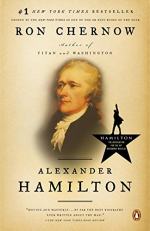|
This section contains 686 words (approx. 2 pages at 400 words per page) |

|
Alexander Hamilton (biography) Summary & Study Guide Description
Alexander Hamilton (biography) Summary & Study Guide includes comprehensive information and analysis to help you understand the book. This study guide contains the following sections:
This detailed literature summary also contains Topics for Discussion on Alexander Hamilton (biography) by Ron Chernow.
“Alexander Hamilton” is biographical account of the life of American Founding Father, Alexander Hamilton, by Ron Chernow. Not only does Chernow provide an account of Hamilton’s life, but he provides analysis for the reader along the way.
Alexander Hamilton’s precise birthdate is unknown, but is believed to be January 11, 1755 on the island of Nevis in the British West Indies. Hamilton is an illegitimate child, raised along with his older brother by his mother. At a young age, Hamilton develops a love for reading. After his mother dies, the young Hamilton comes to support himself by working as a shipping clerk, while beginning to pen poetry for the local newspaper. After a bad hurricane hits the island, Hamilton pens an essay on it which is so well-written and so moving it gains the attention of the governor of the island, who takes up a fund so that Hamilton may attend college in North America.
Hamilton ultimately travels to New York, where he becomes a student at King’s College. Hamilton applies himself to his studies, but also begins to pay attention to the growing disenchantment of many Americans with the British. Hamilton begins attending pro-American rallies, and begins to write on behalf of the American cause. Yet, his honorable nature compels him to defend the pro-British president of King’s College from an angry mob one night. The British attacks at Lexington and Concord worsen the situation between the American colonials and the British. Hamilton, along with a group of college students, volunteer to capture several cannons in lower New York before British troops can take them and use them. As the British prepare to crack down on New York, the Battle of Bunker Hill in Boston occurs and gives hope to the American cause. George Washington is sent to command all American troops assembling in New York, where it is expected the next large British attack will occur.
Hamilton is made captain of part of an artillery battalion, where he becomes popular among his men for sharing in their hardships and fighting alongside them. Although the Battle of New York is a loss for the Americans, Hamilton’s heroic actions catch Washington’s attention, and Hamilton comes to serve on Washington’s staff for most of the rest of the war, coming to fight again heroically in the Siege of Yorktown years later. Hamilton, during this time, marries Elizabeth “Eliza” Schuyler, and the two ultimately come to have seven children. After the war ends in victory for the Americans, Hamilton sets up a law practice in New York City, and seeks to make a name for himself in politics. Washington ultimately invites Hamilton to become the first Secretary of the Treasury in U.S. history after Washington is elected the first President of the United States.
Hamilton believes that a stronger central government is needed to keep the states together, and many of his policies – such as for a central bank, a public debt, and standing army – bring him into conflict with men like Thomas Jefferson, James Madison, and John Adams. Hamilton and Jefferson especially begin to feud, which ultimately requires Washington to step in to settle the issues between both men. After Washington’s presidency, Hamilton returns to a private life, but his reputation is tarnished by a sexual affair. By the early 1804, words has also gotten to Vice President Aaron Burr, a former soldier and current lawyer who has at times worked with, and clashed with Hamilton, that Hamilton has said some derogatory things about Burr. Burr demands an apology and a disavowal; Hamilton, as a matter of pride, refuses. The two ultimately come to duel on July 11, 1804, at which time Hamilton deliberately does not shoot Burr as a question of honor, while Burr intentionally shoots and hits Hamilton. Hamilton dies the next day while Burr shows no remorse. Burr’s reputation is ruined, while Hamilton’s reputation is temporarily revived. Eliza Hamilton goes on to raise her children as a widow, supported financially by friends and family. Eliza lives on until 1857, defending her husband’s reputation until she dies.
Read more from the Study Guide
|
This section contains 686 words (approx. 2 pages at 400 words per page) |

|



